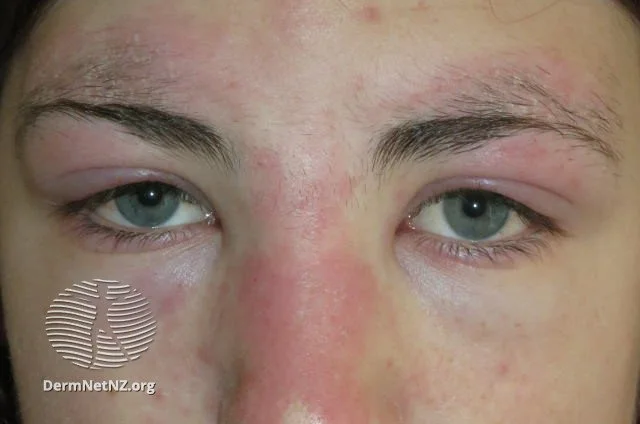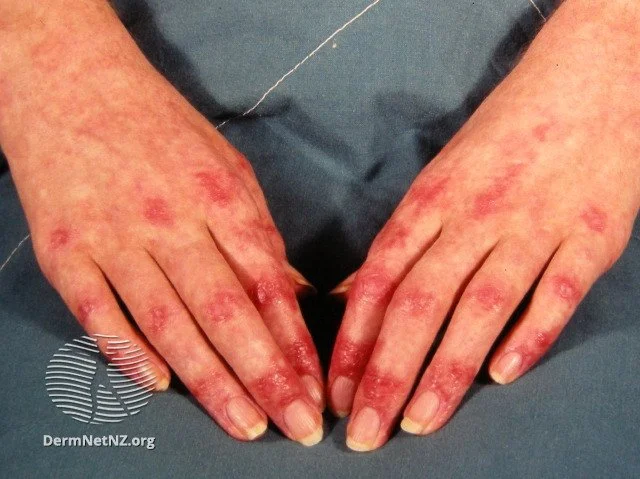
Dermatomyositis
An example of a heliotrope rash in dermatomyositis, a violaceous rash that shows up in sun-exposed areas.
Credit: DermNet NZ
What is dermatomyositis?
Dermatomyositis is a rare inflammatory condition marked by muscle weakness and a distinctive skin rash. While the progression of symptoms can be either abrupt or gradual, the exact origin of dermatomyositis remains elusive, necessitating comprehensive testing and biopsy for accurate diagnosis.
What causes dermatomyositis?
The underlying cause of dermatomyositis is yet to be conclusively identified. Nevertheless, it is postulated to be an autoimmune disorder, potentially linked to aberrations in the blood vessels. Factors potentially heightening the risk include:
Genetic susceptibility
Presence of concurrent malignancies (cancers)
Exposure to certain viral pathogens or toxins
Pre-existing autoimmune disorders
Consumption of specific drugs, like hydroxyurea, penicillamine, statins, quinidine, and phenylbutazone
What are the symptoms of dermatomyositis?
Dermatomyositis often first manifests as a distinctive rash, which may precede or coincide with muscle weakness. This rash can present a range of symptoms, from being asymptomatic to causing itchiness or a burning sensation. The disease is multifaceted, and solely relying on the rash for diagnosis can be misleading. Dermatological indications include:
Violet or reddish patches on sun-exposed zones
Purple-hued rashes on the face, shoulders, chest, and elbows
Darkened eyelids
Scaly scalp accompanied by hair thinning
Ragged cuticles revealing underlying capillaries
Firm subcutaneous nodules
Muscle weakness predominantly affects proximal muscles (shoulders and hips), and while usually painless, can occasionally cause tenderness. This weakness can compromise:
Stair climbing or walking
Transitioning from sitting or recumbent positions
Swallowing
Lifting tasks
Raising arms overhead
About 1/3 of patients with dermatomyositis have amyopathic dermatomyositis, which means they don’t have any muscle involvement.
How do I treat dermatomyositis?
For an effective treatment plan, it's imperative to rule out any underlying triggers through thorough blood work and imaging. While dermatomyositis lacks a definitive cure, its manifestations can be managed. Sun avoidance is crucial to prevent exacerbations, and sunscreen should be applied when exposed to the sun. Potential therapeutic avenues encompass:
Systemic corticosteroids (with prednisone being the primary choice).
Immunosuppressants like methotrexate, mycophenolate mofetil, azathioprine, cyclophosphamide, and cyclosporin.
Biological agents, e.g., rituximab.
Intravenous immunoglobulin at high doses.
Diltiazem and colchicine.
Physical therapy to maintain joint and muscle mobility.
Head elevation during sleep if swallowing is impaired.
Gottron’s papules are another sign of dermatomyositis, which manifests as purple bumps on the bony prominences of the hands.
Credit: DermNet NZ
The Shawl sign in dermatomyositis, which is a purple rash on sun-exposed areas of the chest and upper back.
Credit: DermNet NZ



